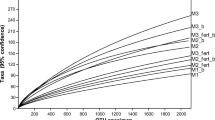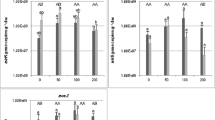Abstract
Crop roots provide dynamic nutrient environments within agroecosystems that can influence the relative abundance and activity of oligotrophic and copiotrophic microorganisms. Copiotrophic organisms grow in carbon (C)-rich environments and their distribution implies that C abundance favors their survival. Survival of oligotrophic organisms is dependent on their ability to multiply and maintain activity in habitats of low C flux. To determine if spatial variation in available C along the root coincides with different physiological groups of bacteria, we isolated bacteria from the rhizosphere at different locations along the tap root of lettuce and tomato plants grown under greenhouse and field conditions. In all five experiments, the overall numbers of both oligotrophs and copiotrophs were high at the upper portions of the root and lower at tip locations and in the bulk soil environment. Consistent patterns in the ratio of copiotrophic to oligotrophic (C:O) bacteria along the roots of lettuce and tomato were obtained and clearly showed that the C:O ratio was different for these two crop species. With lettuce, C:O ratios were high at the root tip (1.22 to 1.61) and upper mid-root locations (0.90 to 1.30), intermediate at the lower mid-root locations (0.73 to 0.95), and low at the root base (0.56 to 0.76). With tomato, C:O ratios were low at root tip locations (0.50 to 0.68) and high at mid and base locations along the root (1.20 to 1.28). These differences may reflect qualitative and quantitative differences in root exudates between these crop species. In our experiments, nitrogen (N) concentrations and lateral branch sites, providing C sources, were important factors influencing bacterial populations in the rhizosphere of lettuce and tomato. Competitive interactions between microorganisms and physiological constraints with respect to substrate affinity may be two important mechanisms influencing bacterial populations and structure of rhizosphere communities.
Similar content being viewed by others
Author information
Authors and Affiliations
Additional information
Received: 14 August 1996; Accepted: 10 December 1996
Rights and permissions
About this article
Cite this article
Maloney, P., van Bruggen, A. & Hu, S. Bacterial Community Structure in Relation to the Carbon Environments in Lettuce and Tomato Rhizospheres and in Bulk Soil. Microb Ecol 34, 109–117 (1997). https://doi.org/10.1007/s002489900040
Issue Date:
DOI: https://doi.org/10.1007/s002489900040




